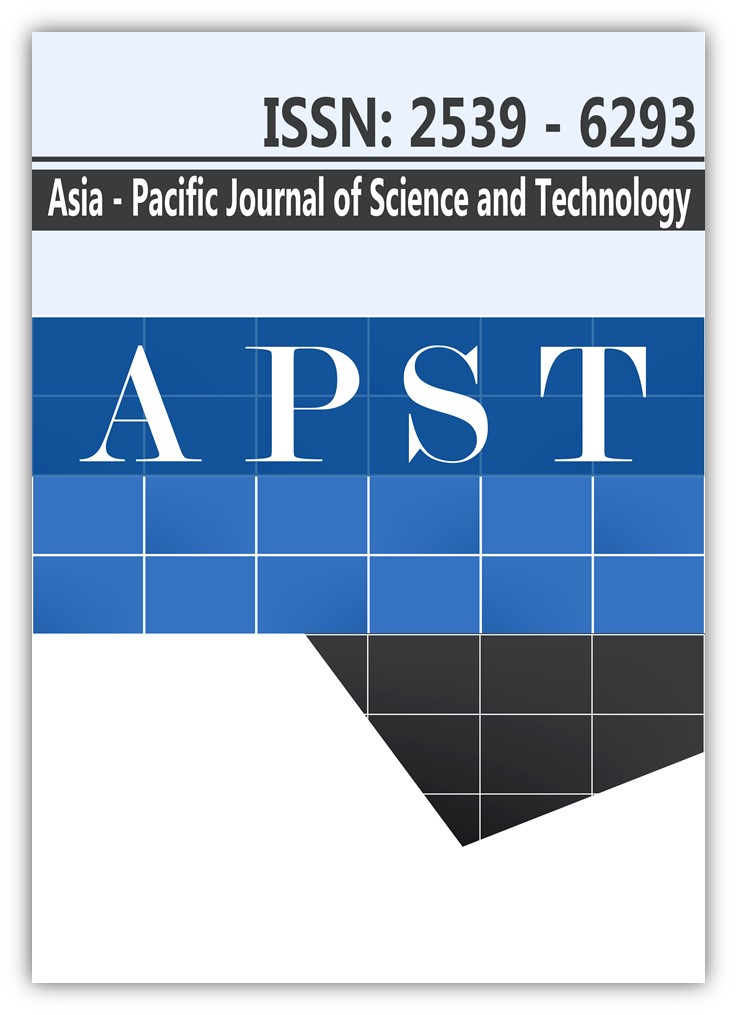Cryopreservation of Cordyceps militaris (L.) link using a vitrification method
Main Article Content
Abstract
Cordyceps militaris (L.) link has been traditionally consumed as an edible and medicinal fungus due to its pharmacological potential. C. militaris is widely cultivated on artificial mediums, but their growth and production are usually affected by excessive sub-culturing. The aim of this study was to investigate the effects of preservation conditions, including the concentrations of cryoprotectants, freezing temperatures, and storage times, on the colony diameters and the fruiting body production of C. militaris. The results indicated that at the freezing temperature of -196 ˚C, the fruiting bodies of C. militaris could be stored for 6 months. After 3 weeks of regrowth, the highest recovery percentage of cryopreserved fruiting bodies (100%) and mycelial discs (100%) were obtained after the samples had been exposed to 10% glycerol at -196 ˚C. Moreover, the development of fruiting bodies from the fungal preservation under the optimized conditions had been able to be completely induced. This study has established a simple and efficient preservation method for C. militaris.
Article Details
References
Shrestha B, Zhang W, Zhang Y, Liu X. The medicinal fungus Cordyceps militaris: research and development. Mycol Prog. 2012;11:599-614.
Cui J. Biotechnological production and applications of Cordyceps militaris, a valued traditional Chinese medicine. Crit Rev Biotechnol. 2015;35(4):475-484.
Luo X, Duan Y, Zhang W, Li C, Zhang J. Structural elucidation and immunostimulatory activity of polysaccharide isolated by subcritical water extraction from Cordyceps militaris. Carbohydr Polym. 2017;157:794-802.
Wang B, Lee C, Chen Z, Yu H, Duh P. Comparison of the hepatoprotective activity between cultured Cordyceps militaris and natural Cordyceps sinensis. J Funct Foods. 2012;4:489-495.
Sun S, Deng C, Zhang L, Hu K. Molecular analysis and biochemical characteristics of degenerated strains of Cordyceps militaris. Arch of Microbiol. 2017;199:939-944.
Yin J, Xin X, Weng Y,Gui Z. Transcriptome-wide analysis reveals the progress of Cordyceps militaris subculture degeneration. PLoS One. 2017;12(10):1-14.
Homolka L. Preservation of live cultures of basidiomycetes - recent methods. Fungal Biol. 2014;118:107-125.
Homolka L, Lisa L, Eichlerova I, Valaskova V, Baldrian P. Effect of long-term preservation of basidiomycetes on perlite in liquid nitrogen on their growth, morphological, enzymatic and genetic characteristics. Fungal Biol. 2010;114:929-935.
Ifeanyi N, Okorie N, Marshall E. Germplasm preservation and propagation; the foundation of agricultural development-a review. J Pharm Biol Sci. 2016;11:70-73.
Nam S, Li C, Li Z, Fan M, Kang S, Lee K, et al. Long-term preservation, regeneration, and cultivation of Paecilomyces tenuipes (Peck) Samson (Ascomycetes), an entomopathogenic gungus inoculated into the silkworm larva of Bombyx mori. Int J Med Mushrooms. 2011;13:83-91.
Sung J, Park Y, Lee P, Han S, Lee W, Choi S, et al. Effect of preservation periods and subcultures on fruiting body formation of Cordyceps militaris in vitro. Mycobiology. 2006;34(4):196-199.
Huang L, Li Q, Chen Y, Wang X, Zhou X. Determination and analysis of cordycepin and adenosine in the products of Cordyceps spp. Afr J Microbiol Res. 2009;3(12):957-961.
Elliott G, Wang S, Fuller B. Cryoprotectants: a review of the actions and applications of cryoprotective solutes that modulate cell recovery from ultra-low temperatures. Cryobiology. 2017;76:74-91.
Jang T, Park S, Yang J, Kim J, Jae H, Park U, et al. Cryopreservation and its clinical applications. Integr Med Res. 2017;6:12-18.
Leibo S, Pool T. The principal variables of cryopreservation: solutions, temperatures, and rate changes. Fertil Steril. 2011;96(2):269-276.
Linde G, Luciani A, Lopes A, Valle J, Colauto N. Long-term cryopreservation of basidiomycetes. Braz J Microbiol. 2018;49:220-231.
Miguel A, Ayala ZM, Gallou A. Berlanga PA, Andrade MG, Rodriguez RJ, et al. Viability, purity, and genetic stability of entomopathogenic fungi species using different preservation methods. Fungal Biol. 2017;121:920-928.
Singh S, Upadhyay R, Kamal S, Tiwari M. Mushroom cryopreservation and its effect on survival, yield and genetic stability. Cryo Letters. 2004;25:23-32.
Tanaka H, Mantovani T, Santos M, Linde G, Colauto N. Cereal grains and glycerol in Agaricus blazei cryopreservation. J Biosci. 2013;29:627-633.
Colauto N, Eira A, Linde G. Cryopreservation at -80 ˚C of Agaricus blazei on rice grains. World J Microbiol Biotechnol. 2011;27:3015-3018.
Sun H, Hu T, Guo Y, Liang Y. Preservation affects the vegetative growth and fruiting body production of Cordyceps militaris. World J Microbiol Biotechnol. 2018;34(11):1-9.
Freitas A, Araújo M, Hendges E, Azevedo A, Lima D, Cruz I, et al. Viability of Metarhizium anisopliae conidia (metsch.) sorok preserved in packages containing silica gel. BMC Proc. 2014;8(Suppl 4):1-8.
Ayala ZM, Gallou A, Berlanga PA, Serna DM, Arredondo BH, Montesinos MR. Characterization of entomopathogenic fungi used in the biological control program of Diaphorina citri in Mexico. Bio control Sci Technol. 2015;25:1192-1207.
Crahay C, Declerck S, Colpaert J, Pigeon M, Munaut F. Viability of ectomycorrhizal fungi following cryopreservation. Fungal Biol. 2013;117:103-111.


